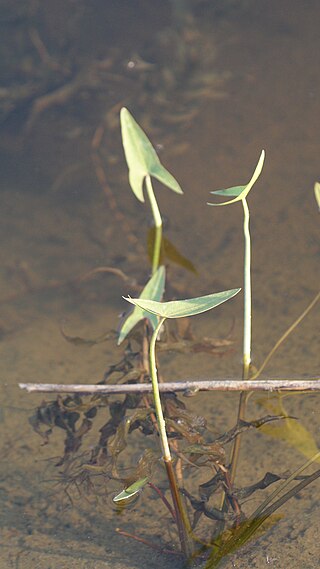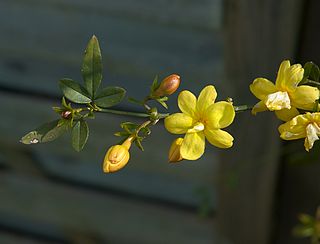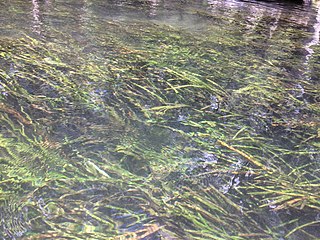Utricularia floridana, the Florida yellow bladderwort, is a large affixed aquatic carnivorous plant in the bladderwort genus within the bladderwort family). It is a perennial plant that is endemic to southeastern United States.

Sagittaria montevidensis is a species of flowering plant in the water-plantain family Alismataceae. Common names include giant arrowhead and California arrowhead.

Quercus chapmanii, commonly referred to as the Chapman oak, is a species of oak that grows in the southeastern United States.

Sagittaria cuneata is a North American species of flowering plant in the water plantain family known by the common name arumleaf arrowhead or duck potato. Like some other Sagittaria species, it may be called wapato.

Sagittaria longiloba is a species of flowering plant in the water plantain family known by the common name longbarb arrowhead and Gregg arrowhead. It is native to the south-central and southwestern United States plus Mexico, Venezuela and Nicaragua. It is also reportedly naturalized in the western Himalayas of India and Bhutan. It grows in slow-moving, stagnant, and ephemeral water bodies such as ponds and small streams, and sometimes disturbed and cultivated habitat such as rice fields and irrigation ditches.

Jasminum mesnyi, the primrose jasmine or Japanese jasmine, is a species of flowering plant in the family Oleaceae, native to Vietnam and southern China. It is also reportedly naturalized in Mexico, Honduras and parts of the southern United States.

Cardamine douglassii, the limestone bittercress or purple cress, is a perennial forb native to the eastern and central United States as well as the province of Ontario in Canada, that produces white to pink or purple flowers in early spring.

Sagittaria australis, the Appalachian arrowhead or longbeak arrowhead, is a plant found in North America. It is a perennial herb up to 130 centimetres tall. It is an unusual Sagittaria species in that it has a 5-winged petiole. The flowers are up to 3 cm (1 in) in diameter, white, producing an achene with a recurved beak.

Najas gracillima, the slender waternymph, is a submerged species of aquatic plant in the Hydrocharitaceae family. found in lakes and streams. It is native to China, Russian Far East, Japan, Korea, Taiwan, Iran, Alberta, Ontario, Newfoundland, Nova Scotia, New Brunswick, the eastern United States. It is also considered introduced and naturalized in France, Spain, Italy and California.

Sagittaria isoetiformis, common name quillwort arrowhead, is an aquatic plant species native to Cuba and to the southeastern United States.

Sagittaria kurziana, common names springtape and strap-leaf sagittaria, is an aquatic plant species native to Florida and naturalized in the Mariana Islands. It grows along large springs, very often those with high sulfur content, and along the banks of watercourses downstream from such springs.

Sagittaria cristata, the crested arrowhead, is a perennial herb growing up to 75 centimetres tall. The leaves are flat, long and narrow, not lobed, and up to 40 cm (16 in) long. The flowers are white.

Sagittaria teres, the quill-leaved arrowhead or slender arrowhead, is an aquatic plant species in the genus Sagittaria native to the northeastern United States: Rhode Island, Massachusetts, New Hampshire, New York and New Jersey.

Sagittaria ambigua, the Kansas arrowhead, is an aquatic plant species native to North America. It is a perennial herb growing up to 90 centimetres tall. The leaves are broadly lanceolate, the blade up to 20 cm (8 in) long and 12 cm wide.

Sagittaria brevirostra, common name Midwestern arrowhead or shortbeak arrowhead, is an aquatic plant species native to North America. It is a perennial herb growing up to 70 centimetres tall, with arrow-shaped leaves and white flowers.

Sagittaria engelmanniana is a perennial aquatic plant growing up to 70 centimetres tall. The leaves are sagittate (arrow-shaped) with 3 very narrow lobes.

Sagittaria graminea, the grassy arrowhead or grass-leaved arrowhead, is an aquatic plant species native to eastern North America.

Sagittaria guayanensis, the Guyanese arrowhead, is a perennial aquatic plant species native to both the Old and New World. It has broadly hastate (arrow-shaped) leaves with ovate lobes.

Sagittaria subulata, the awl-leaf arrowhead, narrow-leaved arrowhead or dwarf sagittaria, is an aquatic plant species that grows primarily in shallow brackish water along the seacoast, in marshes, estuaries, etc. It is native to the Colombia, Venezuela, and every US state along the coast from Massachusetts to Louisiana. It has also been reported as naturalized in Great Britain on just three occasions; only one of these is recent and it appears to have become extinct by 2010. It is also recorded as a non-native on the Azores, and on the Island of Java in Indonesia.

Sagittaria macrocarpa, commonly called the large-fruited arrowhead, is an aquatic plant species known only from the US states of North Carolina and South Carolina.



















